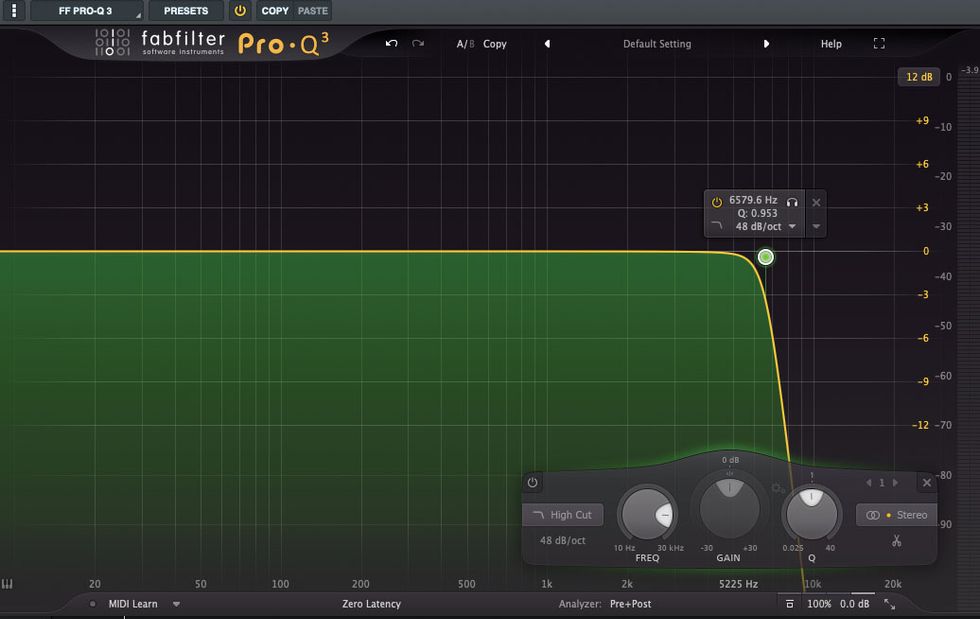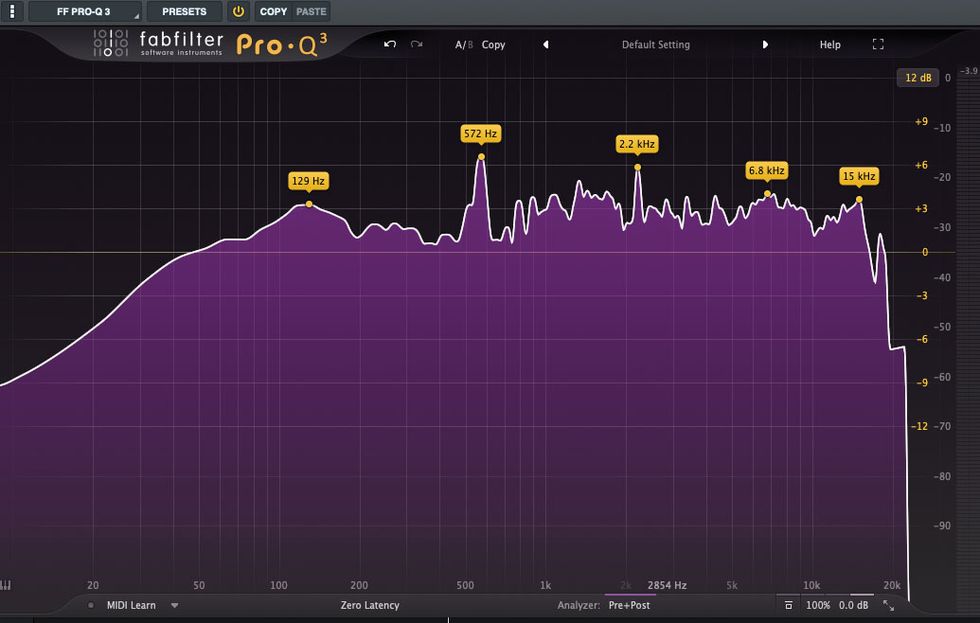See how this badass Texan uses her signature Epiphone Sheratons to create pop-music earworms that get wrapped in barbed wire thanks to a “patent-pending,” 3-pedal-combination trademark.
Emily Wolfe doesn’t play guitar. She bends it to her will. Like a bronco buster taming a stallion, she saddles up on her signature Sheratons and lets it rip. Much of the magic felt and heard on her self-titled debut was pure adrenaline hitting your speaker. Her second album, 2021’s Outlier, incorporated Wolfe’s love of Motown grooves and modern-pop stickiness, both of which refreshed her songwriting with backdrops of more polished, waxy tones, but tumbleweed oscillation, helicopter, square-wave chops, and barbed-wire fuzz are still howls welcomed in this Wolfe pack.
“When I go up there, something could hit me at any point—an emotion that I felt 10 years ago could come out in a bend on the low E. There’s so much rawness [to classic rock]; the edges are not perfect, but there’s a magic in that,” Wolfe told PG in 2021.
But how do you marry earworm poppiness with a gunslinger’s approach to guitar?
“Some of my rock friends say, ‘Pop isn’t relevant,’ and I’m like, ‘What are you talking about—it’s everywhere!’ It’s so sticky for people, and that’s really fascinating to me. I want my music to have that quality … but also the realness of a raw guitar tone. [With Outlier] I wanted to make something that would be classic 10, 20, 30 years from now,” she explained in our profile. “That was the goal, and I think we achieved it.”
Before Wolfe’s headlining show at Nashville’s Blue Room (located inside the Third Man Records compound), PG’s Chris Kies joined the shredding songwriter onstage to talk shop. The resulting conversation covers the development behind her Epiphone Sheraton, how a boring night in Cleveland spent with her “Chex-mix-crushing, brother-in-tone” bass player Evan Nicholson convinced her to play a doubleneck guitar, and we discover what three pedals work together to make what she describes as “the sound that belongs to me.”Brought to you by D'Addario XPND.
Signature Steed
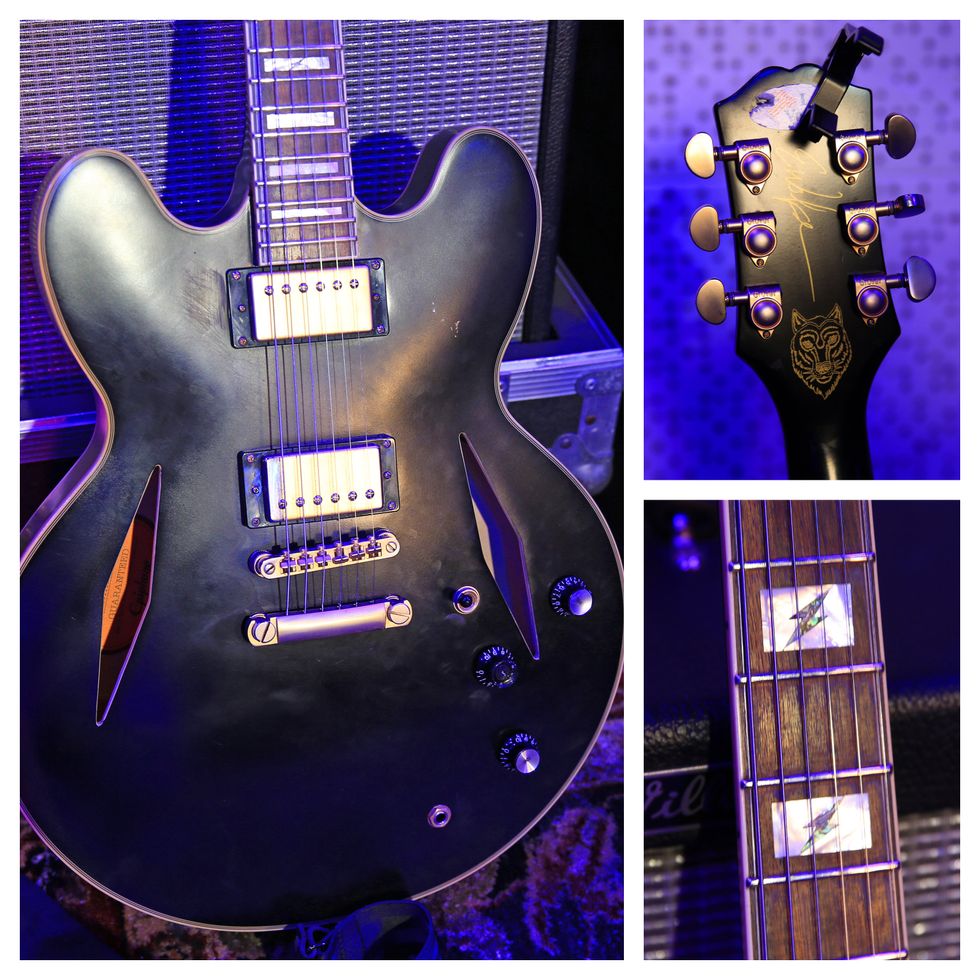
Emily Wolfe’s first “real” guitar was an Epiphone Sheraton. (She really wanted a Gibson ES-355 like blues hero B.B. King, but Wolfe was just a strapped college student.) That first experience with a semi-hollowbody guitar had a seminal influence on her guitar-playing journey, contributing to her singular sound. “Every decision I made with my gear was as a result of building my tone around that first Sheraton.” Now honored with a signature Epiphone Sheraton of her own, the Stealth is a modern take on John Lee Hooker’s longtime favored ride. It has a layered maple body with a mahogany neck, signature bolt inlays, a Tune-o-matic bridge, CTS pots, two volume controls and one tone control, and Epiphone’s Alnico Classic PRO pickups. She discreetly put her John Hancock on the back of the headstock. She uses Ernie Ball Slinky Cobalt strings (.010–.046) and strikes them with Dunlop Tortex Jazz III .88 mm picks. This one stays in either standard or drop-D tunings.
The White Wolfe
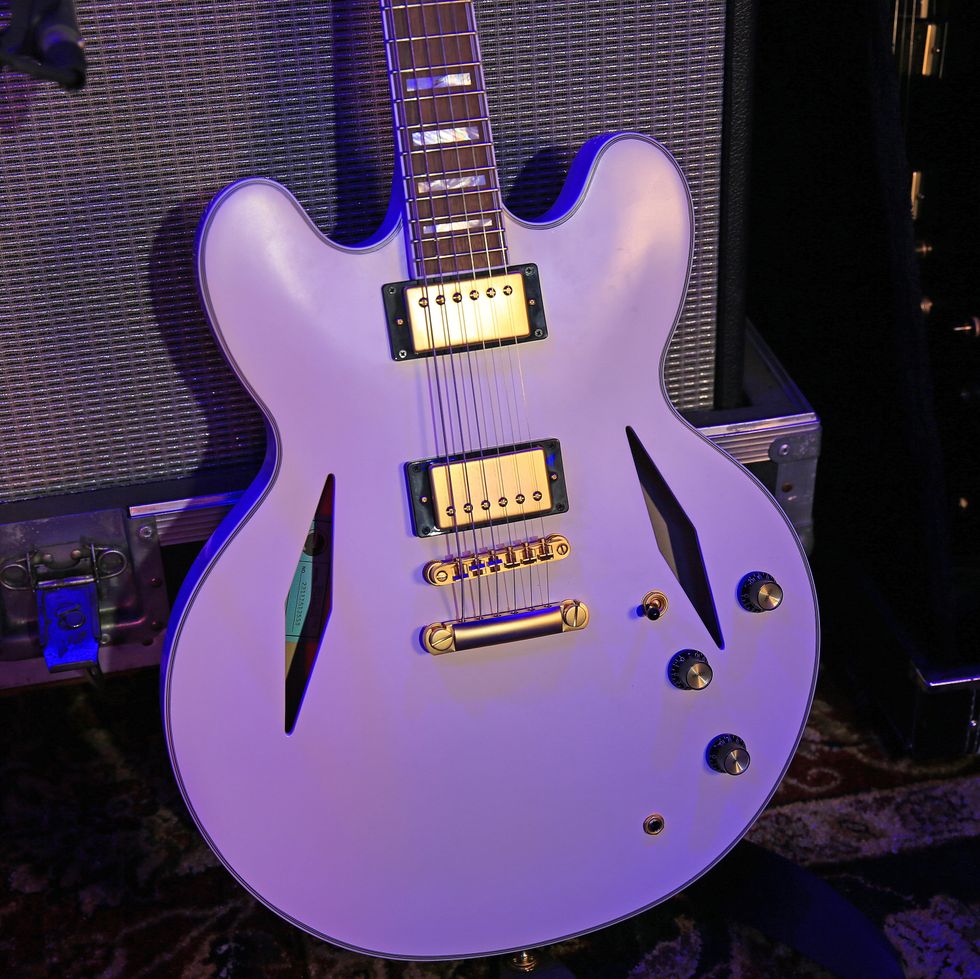
The “White Walker” edition of Emily’s signature Stealth features all the same specs of the black model aside from the aged bone white finish. This one does take a custom set of Slinkys (.012–.060) and holds a Wolfe-tweaked open-C tuning (C–G–C–E–A–D).
You could win your own if you enter this giveaway before October 20, 2023. Click here to enter
Double Trouble
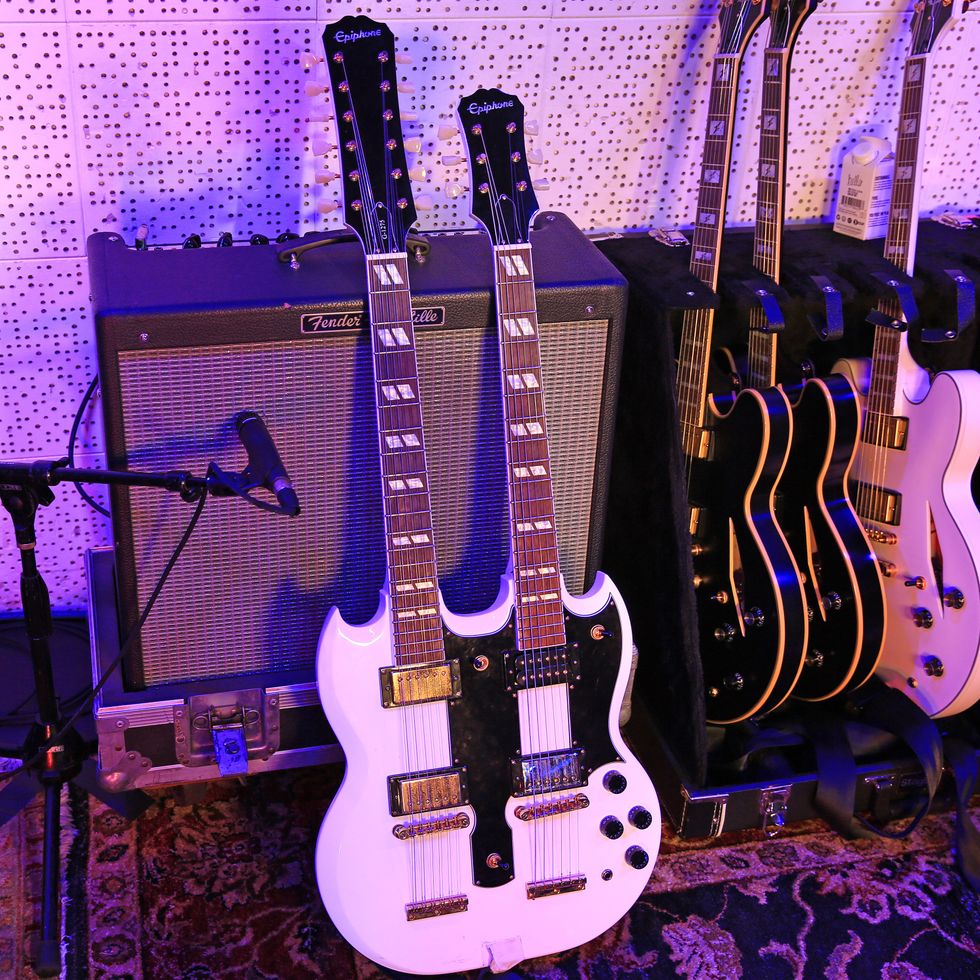
How does a boring night in a Cleveland hotel lead to Wolfe owning a doubleneck Epiphone? Well, her bass player (and best friend) Evan Nicholson wondered if Wolfe had ever tried a doubleneck guitar. She said ‘no,’ and so started the quest to prove that women can rock a pair of necks, too! She acquired this Epiphone G-1275 and uses it mainly for her cover of T. Rex’s “The Slider” by using the lower 6-string (in drop-C) for the rhythm parts and the 12-string for the song’s solo. The two necks tuned separately allow her to put both guitar parts under her hands with one guitar.
Dancing with the DeVille
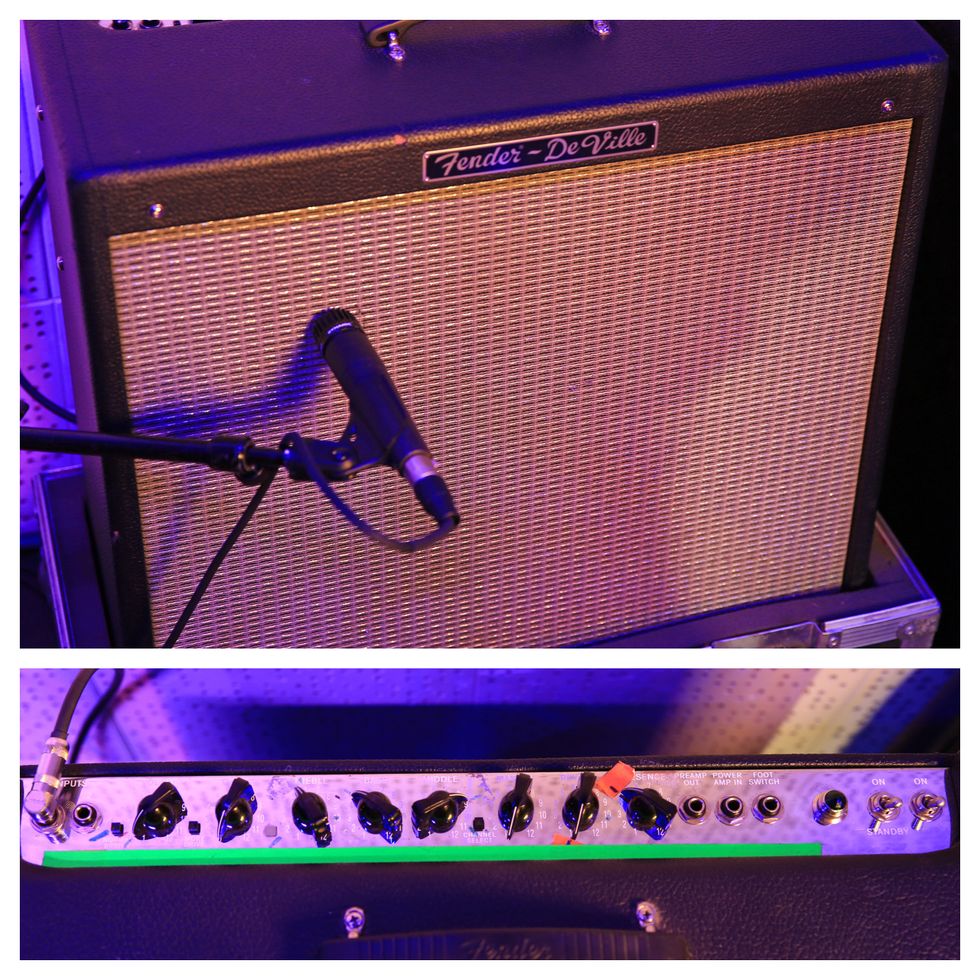
Saying an amp has “no character” might be seen as negative by some, but Wolfe prefers the “middle-of-the-road” base tone in this Fender Hot Rod DeVille 410 III. It packs plenty of volume, and Wolfe adds, “I get to pick what character I want with my pedals.”
Emily Wolfe's Pedalboard
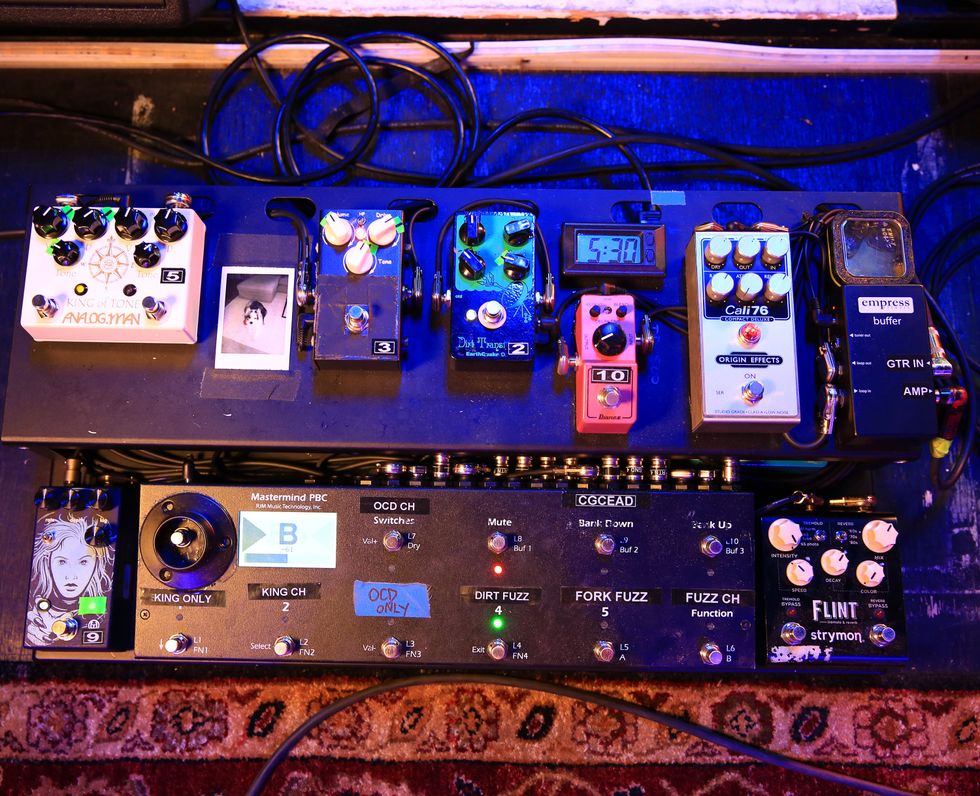
“If I get a new piece of gear, I have to figure out every single part of it before I can really use it,” Wolfe confessed to PG while talking about Outlier. That sensible curiosity has led her to dialing in precise parameters on the pedals and creating colossal combos with singular Wolfe gain staging. Her silver bullet is the EarthQuaker Devices Tentacle analog octave-up pedal, running into a Fulltone OCD, and an MXR Six Band EQ. She claimed to PG, “That’s the sound that belongs to me.” The sequence creates a “crazy fuzztone” from the overdrive. Then she uses the EQ to reduce some of the lows and boost the mids for a sound she says will get her guitar to cut through any mix.
Other spices in the rack include an Analogman King of Tone, an EarthQuaker Devices Dirt Transmitter fuzz, an Ibanez Analog Delay Mini, an Origin Effects Cali76 Compact Deluxe, a Walrus Audio Julia chorus/vibrato, and a Strymon Flint. The Empress Buffer puts the Delay Mini and Flint outside the RJM Mastermind PBC’s control.
But Wait... There's More!
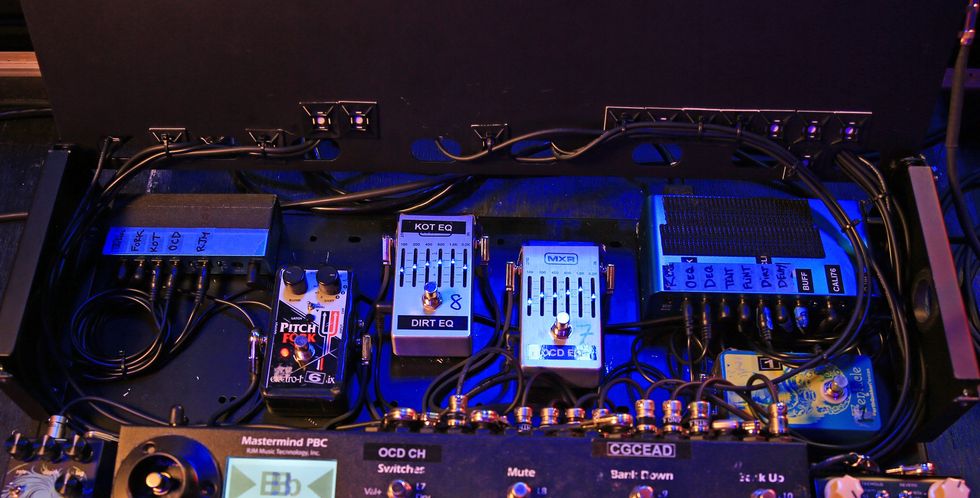
Underneath the hood, Wolfe has tucked in a pair of MXR M109S Six Band EQ pedals (one hitting the King of Tone and the other hitting the OCD), an Electro-Harmonix Pitch Fork, an EarthQuaker Devices Tentacle analog octave up, and a couple of Strymon power supplies (Ojai and Zuma).
Shop Emily's Rig

Epiphone Emily Wolfe "White Wolfe" Sheraton
Ibanez Analog Delay Mini Pedal
Origin Effects Cali76 Compact Deluxe
Empress Buffer
Strymon Flint
Walrus Audio Julia Analog Chorus/Vibrato V2
Electro-Harmonix Pitch Fork
MXR M109S Six Band EQ Pedal
EarthQuaker Devices Tentacle
Strymon Zuma
Strymon Ojai
Note the ability to make pinpoint-precise fixes in both Ozone's Izotope Dynamic EQ (Fig. 1— top) and Fab Filter's Q3 (Fig. 2 — bottom).
Want to surgically fix that "ice pick in the forehead tone?" Check into dynamic EQ.
Greetings everyone, and welcome to another Dojo installment. For my next two columns, we're going to be examining the differences between using a dynamic EQ or a multiband compressor. This month, I'm going to discuss the benefits of using a dynamic EQ in your recordings.
First, let me define what a dynamic EQ is, since it's often confused with a multiband compressor. Essentially, a dynamic EQ is an EQ (with all of the normal attributes: HPF, LPF, notch, and band-pass filters) that also has the added ability to compress a frequency band much like a standard multiband compressor.
On the surface, you might think there's not much different between the two, but I'm going to advocate for you to not be fooled by this generality. If you're not sure what a compressor is or need a refresher, I invite you to review my previous Dojo articles, in the June and July 2020 issues, discussing that very subject. You can also visit my website, bryanclarkmusic.com, for more info. With that said, the Dojo is now open, so let's begin.
"Wouldn't it be nice to have something that would only go to work when those ice-pick frequencies are happening and leave everything else alone?"
I love using dynamic EQs to tame intermittent problem frequencies and pesky gremlin-like spikes on individual tracks within a session (acoustic guitar, electric guitar, bass, vocals, snare, synths, etc.), and I have found they can do this with much more transparency than using a multiband compressor. Izotope's Dynamic EQ (in Ozone) and Fab Filter's Q3 are excellent examples of dynamic EQs (Fig.1 and Fig. 2).
Let's say, for example, your latest and greatest guitar solo has significant parts that sound abrasive, it's making your ears get fatigued, and has that kind of "ice pick in the forehead" tone (to quote Frank Zappa). Usually you're going to want to examine the 2.5 kHz to 3.5 kHz part of the frequency spectrum and start subtracting some of that harshness. However, if you do that using a standard EQ, you're also subtracting those frequencies from the entire solo—even the parts that don't have those annoying artifacts—and thus you could be changing the overall tone of your guitar solo. Wouldn't it be nice to have something that would only go to work when those ice-pick frequencies are happening and leave everything else alone?
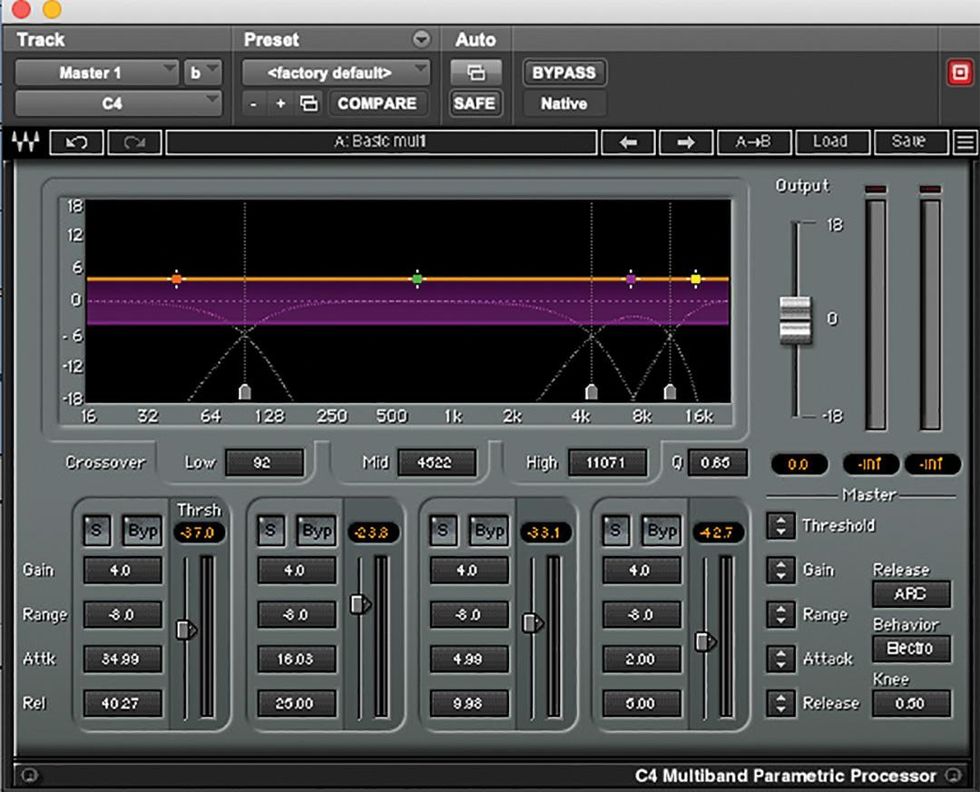
Unlike most multiband compressors, Waves C4 offers expansion, but it also limits the audio spectrum to just four bands.
Here's why I prefer using a dynamic EQ in this scenario: It's more surgical and more transparent. Most multiband compressors generally divide the audio spectrum into three or four bands (Fig.3). You simply set the crossover points to bookend the frequency area(s) of sonic annoyance, and then, by using ratio (4:1, etc.), reduce the aural offenses when they cross over the threshold of the compressor. Dynamic EQs, on the other hand, also do this, but with much more flexibility by increasing the standard three or four bands (or points) to eight or 10, and you can insert the point directly on the offending frequency(s) rather than having to bookend like a multiband compressor. This can be handy if your track has multiple low-end, midrange, and high-end peaks that you need to wrangle. Pro tip: If you have a plethora of frequencies that you're trying to "fix," it's a good sign that you might not have recorded it as best as possible.
Generally, traditional multiband compressors only reduce audio signal once they start working and don't offer the ability to expand or boost the frequencies if you ever have the need. Although, to be fair, a few—like Waves C4 and C6—do offer expansion capabilities. Dynamic EQs, however, are just as capable of boosting the frequencies as reducing them, thus giving you more options to bring out little details that might normally get buried in a traditional multiband compressor.
Finally, and most importantly for me, dynamic EQs use the actual level (or gain) of the frequencies in question rather than using ratios (4:1, 8:1, 12:1, etc.) like compressors do. Because of this design, dynamic EQs are much more transparent and can either reduce or expand frequencies with much less coloration, to get the closest to an ideal recording of your track.
Until next time, be well, be curious, and have fun.
How to use an indispensable DAW tool to focus tracks, find space in a mix, create vintage-style sounds, and more.
Hello everyone, and welcome to another Recording Dojo installment. You may recall that back in November 2020 I introduced you to the mighty HPF (high-pass filter) and how to employ its power. This time, I'm going to focus on the other side of the spectrum: the LPF (low-pass filter). A DAW's LPF does exactly what its name implies: It allows low-frequency information to pass and attenuates the high frequencies. Strategic use of an LPF can really help clean up your recordings and mixes by allowing you to control where and how much high-frequency information you want—especially on groups of tracks where there might be a lot of high-frequency overlap.
Like its cousin the HPF, the LPF also has many of the same parameters and controls—most importantly, the slope of the filter. The slope of the filter is represented by dBs per octave, and the higher the value, the steeper the slope. Typically ranges include -12 dB to -48 dB per octave, but sometimes higher values can be really effective, as we will see.
Here are three scenarios to try that will help you learn how to use a LPF in your mixes.
Scenario 1: acoustic guitar and vocal (or second guitar).
In this situation, you should record your acoustic guitar and your vocal separately, on two different tracks, and not at the same time. If you don't sing, then just play a solo to go along with your acoustic guitar track. First, in your DAW, instantiate and EQ on your acoustic guitar track with an LPF and set it for a -24dB/octave with a center frequency somewhere around 2800 kHz (Fig.1). Next, sweep the frequency to the left and the right and notice how the guitar track will lose its top end (“air") and begin to sound warm. It should immediately start sounding a bit more lo-fi, or like an old recording from last century. Find a frequency range that sounds good to you but is still cutting out a significant amount of the high frequencies and transients of the acoustic guitar. For the vocal track (or your solo track), don't use any EQ at all. Just let it be au naturel. Now listen to both tracks at the same time while toggling the acoustic track's LPF on and off. What you should immediately notice is the vocal track (solo track) will be much more in focus and really have some distance and dimension from the acoustic track when the LPF is active. Season to taste.
Fig. 2
Scenario 2: finding more “space" between the drums and the lead guitar tracks.
Especially in rock music, a significant amount of the drums' energy can come from those cymbals that the drummer is bashing on relentlessly. Cymbals can kill a mix faster than Kryptonite, and they can obscure the subtle pick attacks of lead guitar parts and solos. In this situation, try putting an LPF on the drum overhead tracks, or the main drum track if you are playing with loops, or software instruments, etc. Start around 6,500 kHz (Fig. 2) with -48 dB/octave and sweep around until the drums start to sound warm and the cymbals aren't stepping all over the guitar parts. There are many complex ways to achieve this result, but we have to start somewhere and we want to keep it as simple as possible while putting you in the right territory. For a good reference, listen to U2's “Beautiful Day," and notice how the cymbals don't fatigue your ears or take over the mix.
Scenario 3: using an LPF to make room for a vocal in a mix.
Have a look at Fig. 3 and pay attention to the far right side of the audio spectrum. Notice how the aggressive LPF is literally cutting off high frequency information above 20 kHz. This brick wall (greater than -96 dB/octave) setting can be used to your advantage—especially if your voice (or your singer) has a lot of breathiness and air, but it's getting lost in the mix within the rest of the band. Or perhaps you want to make the mix sound more vintage.
Fig. 3
What we want to do here is sum all of the band tracks except the vocal to a new bus (or track), and then put an LPF on the newly summed track. Here is where you'll want to play around and move quickly to see if you can find that sweet spot between having the band track sounding too dull and giving the vocals the right amount of air or breathiness. Once you dial it in, you can toggle the LPF on and off to hear how the vocals can come in and out of focus.
Don't get frustrated when trying these techniques. It might take some time to really start hearing the differences, and to find ways to use LPFs to your advantage.
Until next time.
![Rig Rundown: Emily Wolfe [2023]](https://www.premierguitar.com/media-library/rig-rundown-emily-wolfe.jpg?id=41738020&width=1245&height=700&quality=85&coordinates=0%2C0%2C0%2C0)


